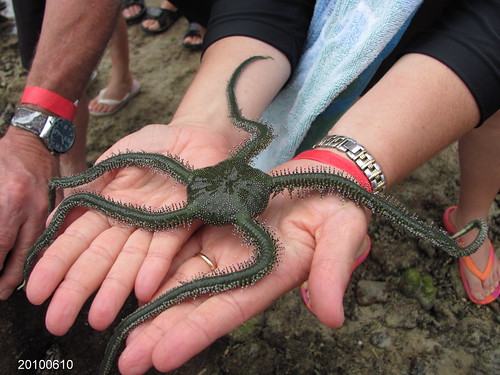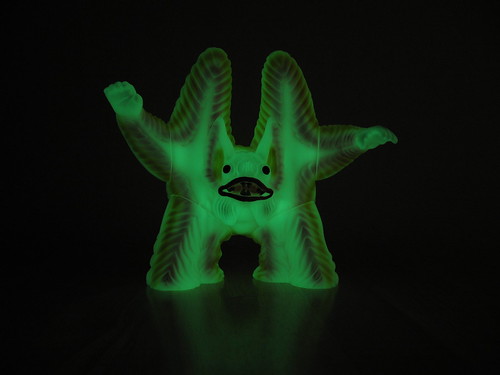 |
| From J. Mallefet's Lab Page |
Their evolution is replete with adaptations to survival that are kind of mind blowing but as with all insanely unusual things, the ideas can be a little unsettling and frankly... a little SPOOOOKKKYY................
1. They don't seem to know when to die...
Most biologists have noticed that echinoderms don't quite die immediately when threatened with the kind of life-threatening injuries that many would consider life-threatening. Or else..its the WRONG part of the animal that seems to go on living... [Yes, some do regenerate (and that will be a subject for a future post!) but not all.] Some examples:
The Story of Stumpy
Here is a true story (although I don't remember who told me this story originally)
Years ago, following a lab accident or perhaps a crab run amok, the disk and 4 arms from a sand starfish (Luidia clathrata) was separated from the mid to end part of its 5th arm.
Contrary to popular myth, not all starfish can regrow a complete body from just the arm. This one certainly could not.
This separated arm tip (which was named "Stumpy") was kept in the water table and continued to move around for weeks to months...(I honestly don't remember how long but it was a long time).
Stumpy was even "fed" clams, which it apparently moved via tube feet to where it thought the mouth was. These clams would move up the tube foot groove and then just...fall out when it reached the disk location. No disk! (and thus no mouth)
It was never clear to me if Stumpy just sort of died on its own or if it creeped everyone out so much that they eventually just preserved it in the lab somewhere.
This isn't necessarily unusual "behavior." One can often observe the arm of a brittle star sometimes continue to move long after it is separated....
Presumably a combination of the unusual radial nervous system and the separated body part's ability to sustain itself using sea water (and nutrients) were responsible for this tenacious behavior?
But why believe an echinoderm zombie story when you can simply watch it...
Here is a "Zombie" Sea Urchin..The animal is broken open with insides removed and yet....IT LIVES
And another...
But on the OTHER hand.....
2. Uh... Do Echinoderms ever die of natural causes??
As a person who has worked in and out of museums and aquariums, one of the things you notice is how some species kept in captivity become bigger and bigger..
Some species such as Pycnopodia helianthoides (from the North Pacific coast)
 |
| Photo by Allison Gong |
 |
| Photo by Mr. J. Volz |
Now, to be clear-they do die. Diseases, aquarium mishaps, introduced predators and so on.
But under optimal conditions?? I have had people watching these cold water species live on for over 10 years (but I'll be honest I would need to verify) and more than once I've been asked "Do they EVER just die of natural causes??"
And honestly, I don't know if they do. Some accounts from the 1960s reported that they became "reproductively senile" but this account was speculative.
The idea of echinoderms as long-lived is not necessarily new. Here is a post I wrote back in 2009 about how ancient sea urchins can get.
So next time you go into say hello to a large sunflower star at your local aquarium-pay it some respect. It might be much older than you are...
3. Some of them GLOW in the Dark!
There is a whole POST worth of stuff on bioluminesence in echinoderms! And at some point in the near future I will write up more about it..but for now accept that a LOT of echinoderms glow!
 |
| Image from J. Mallefet's lab page |
Most people seem to have a fairly benign impression of echinoderms. Harmless shapes that sit on the bottom of the sea floor that make up part of a dreamy seascape...
Here at the Echinoblog I've done everything I can to change this image!
Many starfish and brittle stars can capture MOVING prey and do so in a variety of surprising ways. Imagine ANY of these things as dog or even COW sized and humans would be more respectful of the humble echinoderm...
And just for good measure? Here's an earlier post featuring brittle stars that capture squid or fish if they come too close, rending it apart into pieces!! click here.
5. Dried Echinoderms are MUMMIES, NOT shells
This is probably one of the more macabre things that I've made note of before. Undoubtedly we have all seen starfish decorations for the holidays and weddings??
For example- here's a huge 50 rayed starfish from Antarctica-Labidiaster annulatus which is not only sizeable (up to 2 feet across) but it catches MOVING KRILL with its arms and devours them alive! (yes I've mentioned it before but its one of my favorites!)
And here is the giant tropical brittle star Ophiarachna. Go here to a bunch of links about how this monstrous giant (sometimes) green ophiuroid captures moving fish prey!
And just for good measure? Here's an earlier post featuring brittle stars that capture squid or fish if they come too close, rending it apart into pieces!! click here.
5. Dried Echinoderms are MUMMIES, NOT shells
This is probably one of the more macabre things that I've made note of before. Undoubtedly we have all seen starfish decorations for the holidays and weddings??
 |
| A sad Pisaster ochraceus |
 |
| sad Linckia laevigata |
When sea star (or ANY echinoderm) is prepared dried this way?
This isn't the same as some shell. There is/was skin on them. THESE ARE MUMMIES.
What you are doing above? Is like putting funny clothes on a skeleton or a mummy like this... (which I suppose is fine if you realize what you're doing..)
HAPPY HALLOWEEN!!







7 comments:
The most bizarre thing from this is that many tropical species seem to be a lot more perishable and fragile when kept in captivity (i.e. your typical reef aquarium Echinoderm-related disasters, which have a tendency to befall naive newbies who wish to keep starfish).
Assuming we can feed them with top-notch nutrition, would they last like their cold-water counterparts as well?
Theoretically speaking that is. I am aware of the real problems caused by curio and live animal trade. Their effects can already be felt in many island locations in the Indo-Pacific. You might visit a seemingly healthy reef flat without encountering some of the more-popularly-sold species in certain locations.
I should probably have mentioned that a lot of the animals mentioned were kept primarily in professional aquariums or those run by universities. I don't encounter many people who keep cold-salt species as pets.
There is not only an ecological but a taxonomic difference between most tropical-reef and cold-water/temperate species. And I would confirm the apparent fragility of tropical species-especially given the food sources of the latter species. A lot of tropical aquarium species tend to feed on microalgae and/or biofilms/nutrients which can only be found in the original habitat. The two coldwater species I highlighted in the blog are both predatory. While all sea stars tend to be opportunistic, many species have evolved closely with their habitat and depend on their primary food source. Some tropical groups such as oreasterids (eg Protoreaster), ophidiasterids (eg Linckia) need that original nutrition and I've yet to see them sustained indefinitely. Not that it couldn't be done but I've yet to see it. I know that they will feed on clam meat or whatever if fed but honestly, I don't know if that would do meet their nutritional needs over the long-term especially if other (possibly unknown) environmental factors weren't being met.
The combination of the level of care and food quality would both be important considerations. But I have never seen a aquarium (professional or personal) keep any of the larger tropical water species for very long. Those tiny invasive bat stars that climb in on the rocks would be a different story of course. Again, not that it couldn't be done, but my experience with professional institutions who have kept starfish for long-term periods tends to be w/cold-water-temperate water taxa.
If so then this begs the next question: how about those sea stars kept at touch tanks in various professional aquariums? Consider the high stress rate due to handling by visitors (sometimes rough when unsupervised) as well due to the frequent exposure to the air. Are these specimens (tropical or not) supposed to be kept in the long run, or are they released immediately after a certain period of time?
Most touch-tanks/visitor experience type exhibits rotate the animals out after discrete periods. They do not keep individuals on public "exhibit" for very long. Most of what I've mentioned in the blog is based on exhibit specimens that don't interact with the public.
Chris,
I must say I gained a truly substantial amount of knowledge today. Thank you for your informative article and replies. Will definitely looking forward for your bioluminescent echinoderm articles! I've always been wondering why Plutonaster glows green, for example. There's a beautiful photo of it in imagequest3d (a professional underwater image database).
Happy Halloween!
All incredible tales! I have to say, though, "stumpy" really got to me, with its determination to keep feeding even when there was nothing to put food *into*. Given that lack of nutrition, though, I wonder how long the arm would have lasted?
Thanks for the food for thought!
Post a Comment